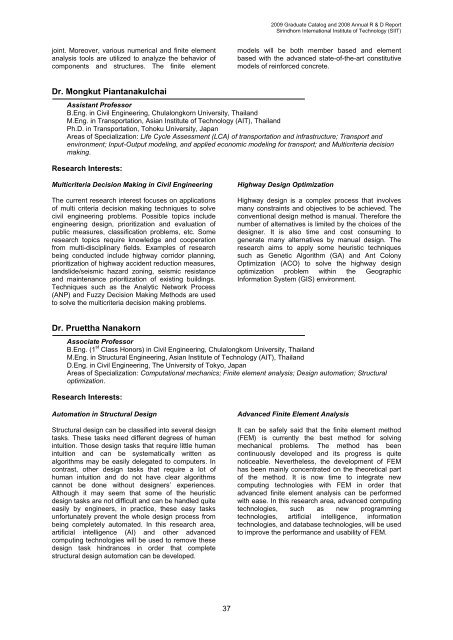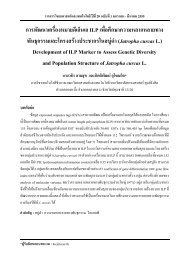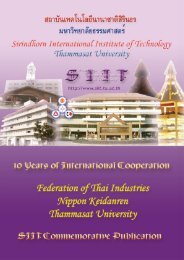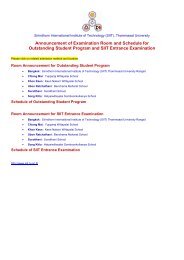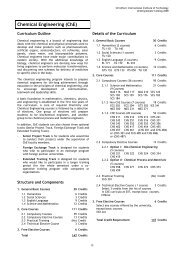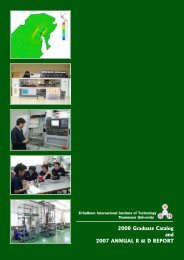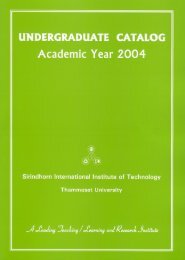2009 Graduate Catalog and 2008 Annual R & D Report - Sirindhorn ...
2009 Graduate Catalog and 2008 Annual R & D Report - Sirindhorn ...
2009 Graduate Catalog and 2008 Annual R & D Report - Sirindhorn ...
- No tags were found...
Create successful ePaper yourself
Turn your PDF publications into a flip-book with our unique Google optimized e-Paper software.
<strong>2009</strong> <strong>Graduate</strong> <strong>Catalog</strong> <strong>and</strong> <strong>2008</strong> <strong>Annual</strong> R & D <strong>Report</strong><strong>Sirindhorn</strong> International Institute of Technology (SIIT)joint. Moreover, various numerical <strong>and</strong> finite elementanalysis tools are utilized to analyze the behavior ofcomponents <strong>and</strong> structures. The finite elementmodels will be both member based <strong>and</strong> elementbased with the advanced state-of-the-art constitutivemodels of reinforced concrete.Dr. Mongkut PiantanakulchaiAssistant ProfessorB.Eng. in Civil Engineering, Chulalongkorn University, Thail<strong>and</strong>M.Eng. in Transportation, Asian Institute of Technology (AIT), Thail<strong>and</strong>Ph.D. in Transportation, Tohoku University, JapanAreas of Specialization: Life Cycle Assessment (LCA) of transportation <strong>and</strong> infrastructure; Transport <strong>and</strong>environment; Input-Output modeling, <strong>and</strong> applied economic modeling for transport; <strong>and</strong> Multicriteria decisionmaking.Research Interests:Multicriteria Decision Making in Civil EngineeringThe current research interest focuses on applicationsof multi criteria decision making techniques to solvecivil engineering problems. Possible topics includeengineering design, prioritization <strong>and</strong> evaluation ofpublic measures, classification problems, etc. Someresearch topics require knowledge <strong>and</strong> cooperationfrom multi-disciplinary fields. Examples of researchbeing conducted include highway corridor planning,prioritization of highway accident reduction measures,l<strong>and</strong>slide/seismic hazard zoning, seismic resistance<strong>and</strong> maintenance prioritization of existing buildings.Techniques such as the Analytic Network Process(ANP) <strong>and</strong> Fuzzy Decision Making Methods are usedto solve the multicriteria decision making problems.Highway Design OptimizationHighway design is a complex process that involvesmany constraints <strong>and</strong> objectives to be achieved. Theconventional design method is manual. Therefore thenumber of alternatives is limited by the choices of thedesigner. It is also time <strong>and</strong> cost consuming togenerate many alternatives by manual design. Theresearch aims to apply some heuristic techniquessuch as Genetic Algorithm (GA) <strong>and</strong> Ant ColonyOptimization (ACO) to solve the highway designoptimization problem within the GeographicInformation System (GIS) environment.Dr. Pruettha NanakornAssociate ProfessorB.Eng. (1 st Class Honors) in Civil Engineering, Chulalongkorn University, Thail<strong>and</strong>M.Eng. in Structural Engineering, Asian Institute of Technology (AIT), Thail<strong>and</strong>D.Eng. in Civil Engineering, The University of Tokyo, JapanAreas of Specialization: Computational mechanics; Finite element analysis; Design automation; Structuraloptimization.Research Interests:Automation in Structural DesignStructural design can be classified into several designtasks. These tasks need different degrees of humanintuition. Those design tasks that require little humanintuition <strong>and</strong> can be systematically written asalgorithms may be easily delegated to computers. Incontrast, other design tasks that require a lot ofhuman intuition <strong>and</strong> do not have clear algorithmscannot be done without designers‟ experiences.Although it may seem that some of the heuristicdesign tasks are not difficult <strong>and</strong> can be h<strong>and</strong>led quiteeasily by engineers, in practice, these easy tasksunfortunately prevent the whole design process frombeing completely automated. In this research area,artificial intelligence (AI) <strong>and</strong> other advancedcomputing technologies will be used to remove thesedesign task hindrances in order that completestructural design automation can be developed.Advanced Finite Element AnalysisIt can be safely said that the finite element method(FEM) is currently the best method for solvingmechanical problems. The method has beencontinuously developed <strong>and</strong> its progress is quitenoticeable. Nevertheless, the development of FEMhas been mainly concentrated on the theoretical partof the method. It is now time to integrate newcomputing technologies with FEM in order thatadvanced finite element analysis can be performedwith ease. In this research area, advanced computingtechnologies, such as new programmingtechnologies, artificial intelligence, informationtechnologies, <strong>and</strong> database technologies, will be usedto improve the performance <strong>and</strong> usability of FEM.37


